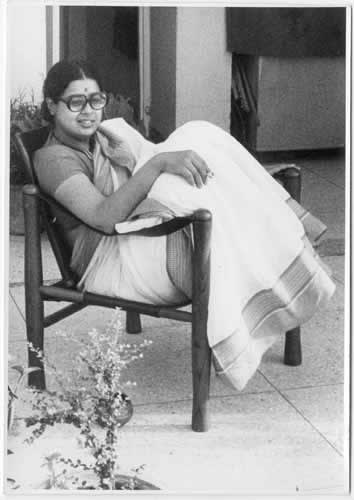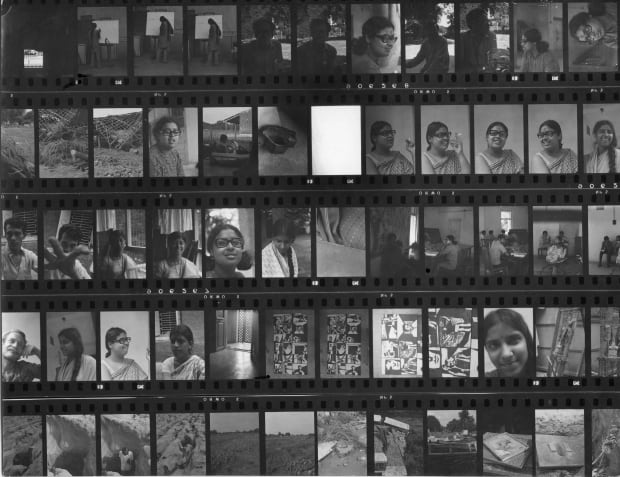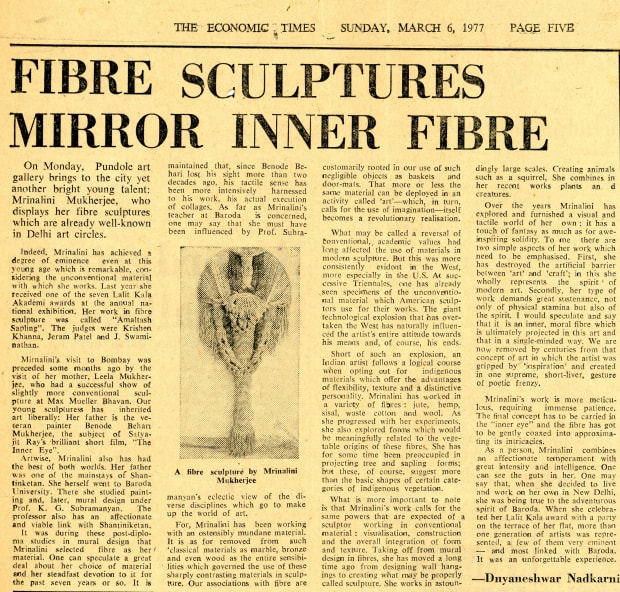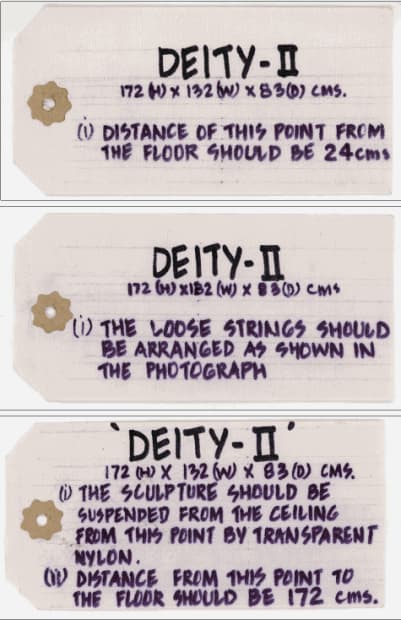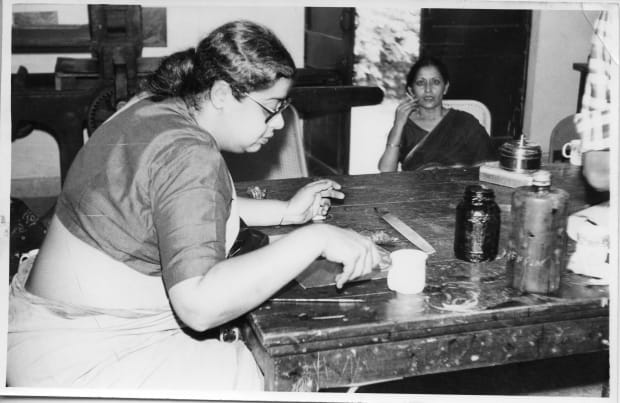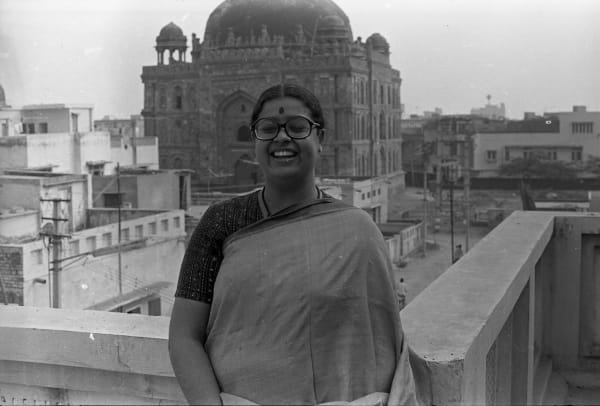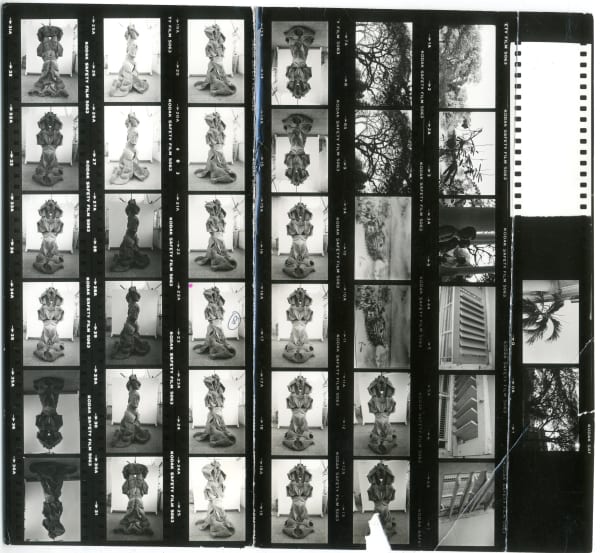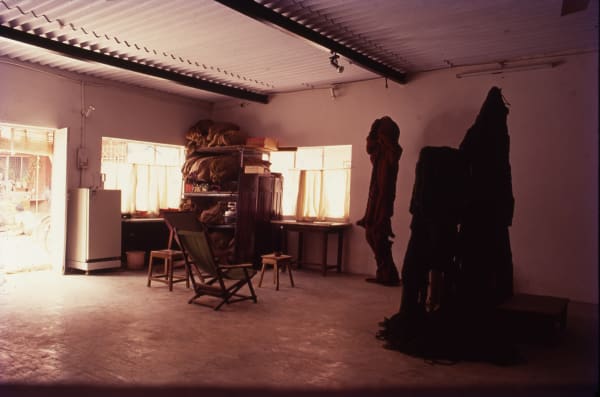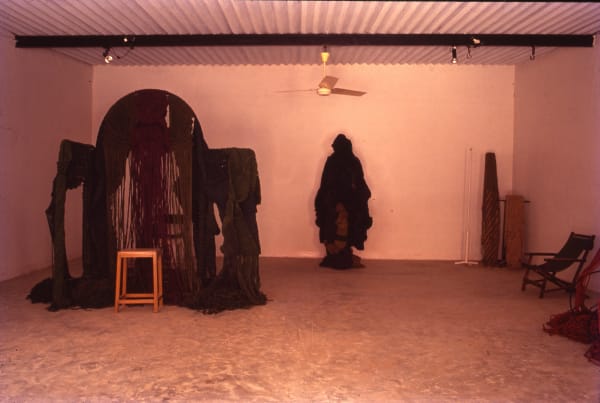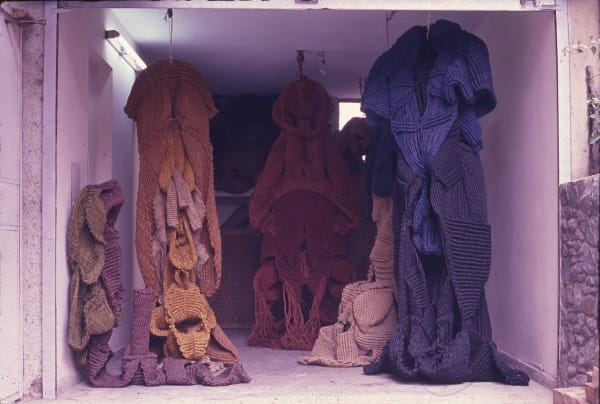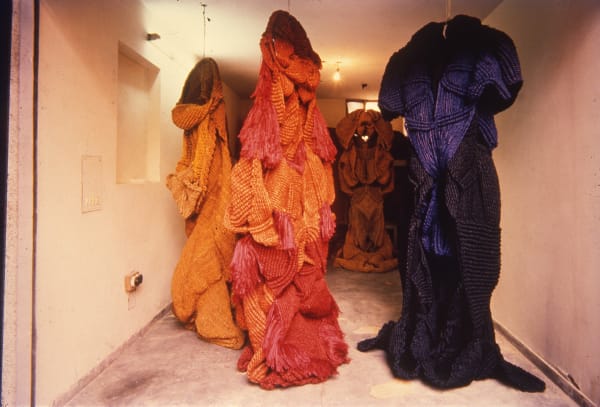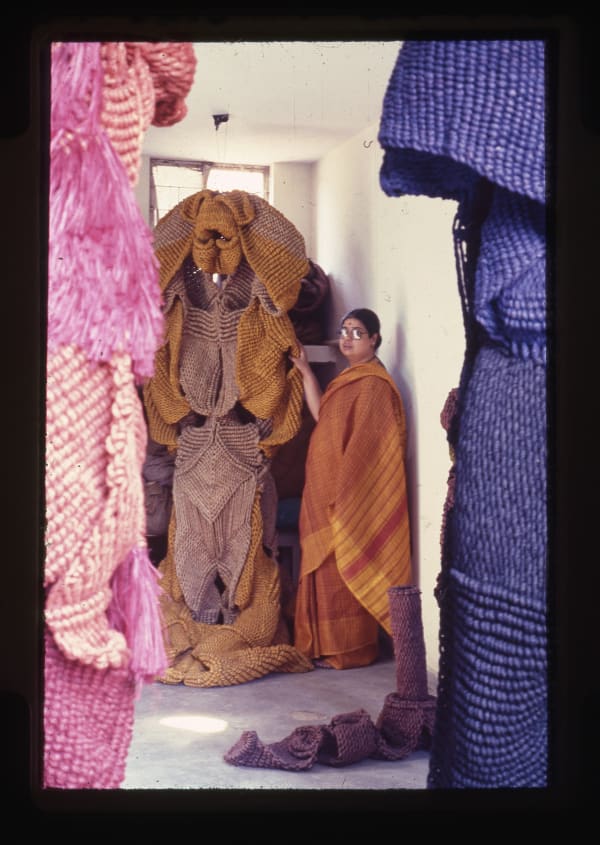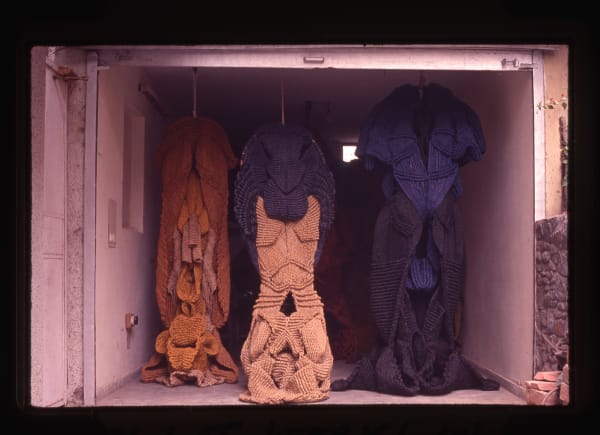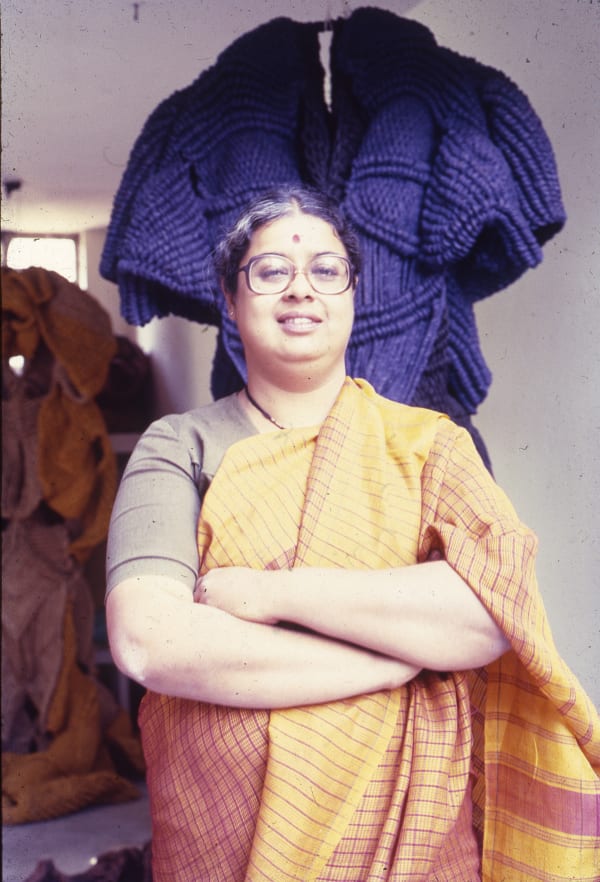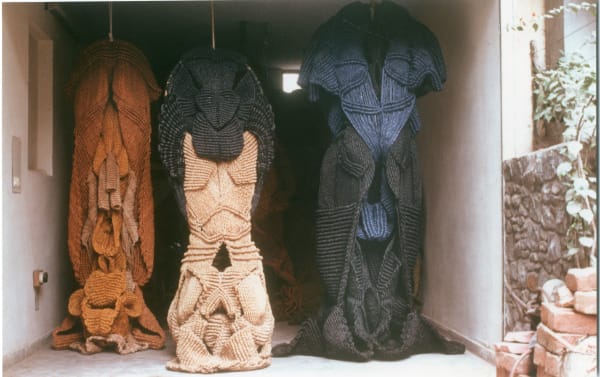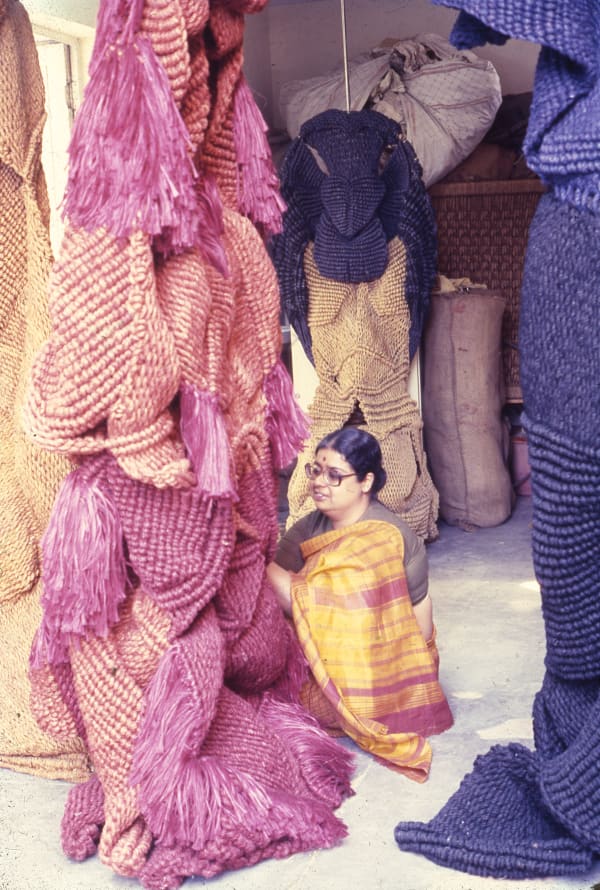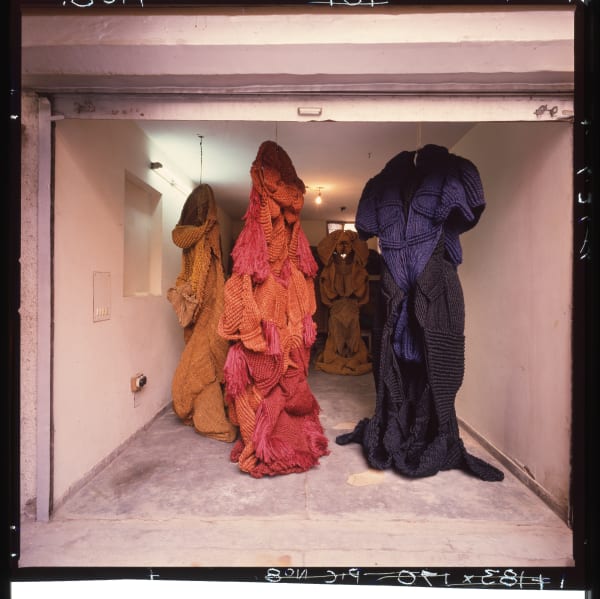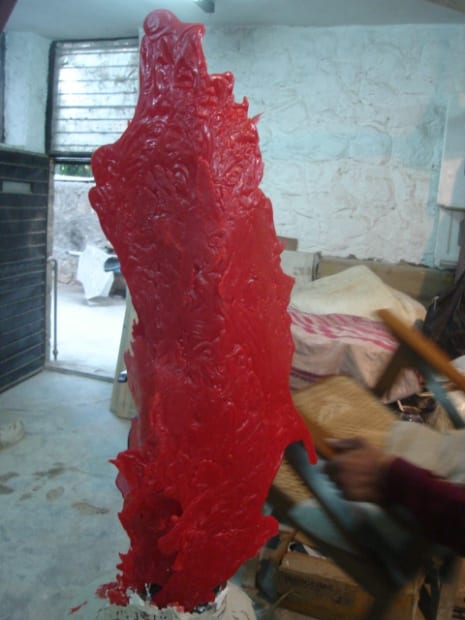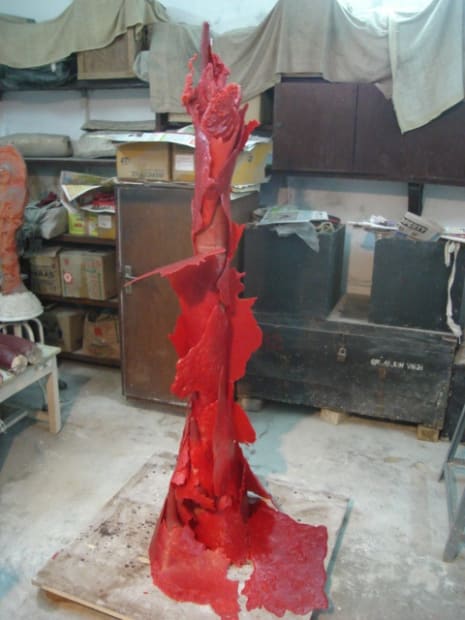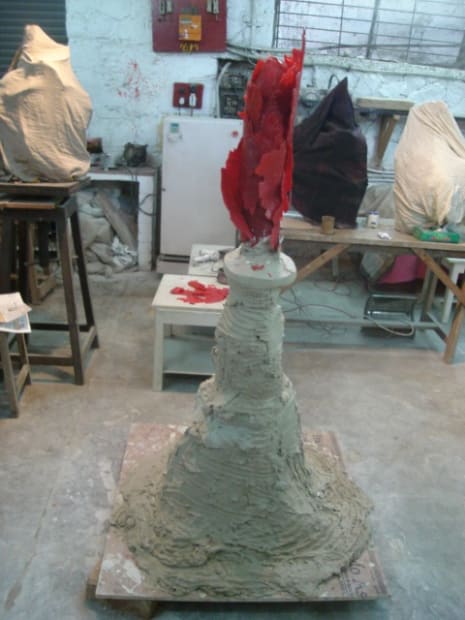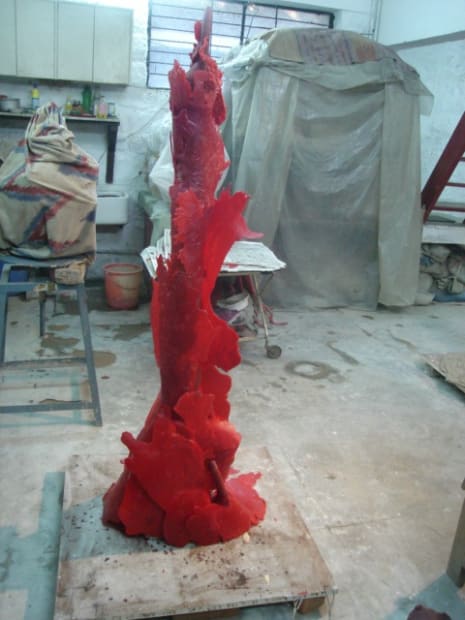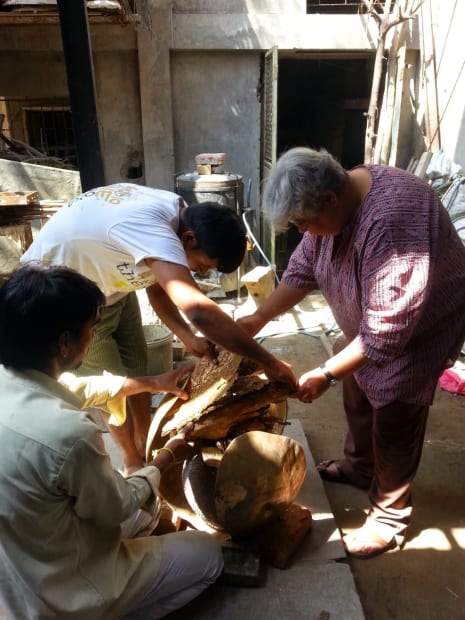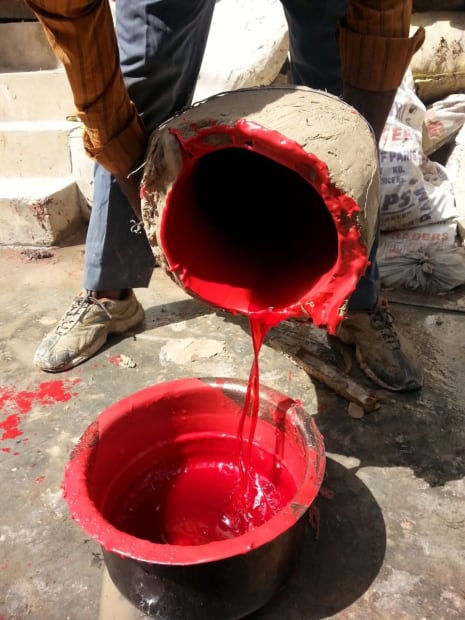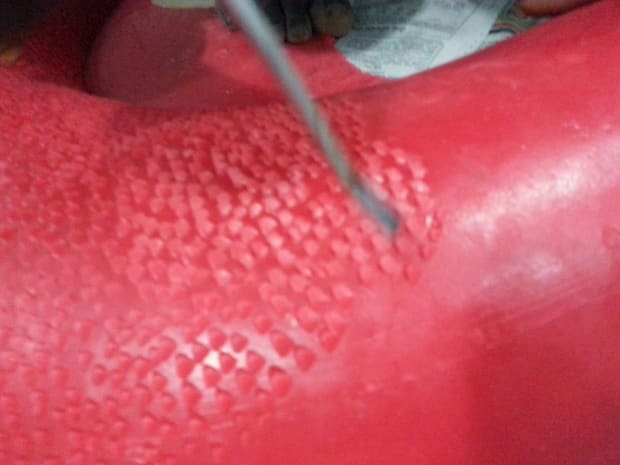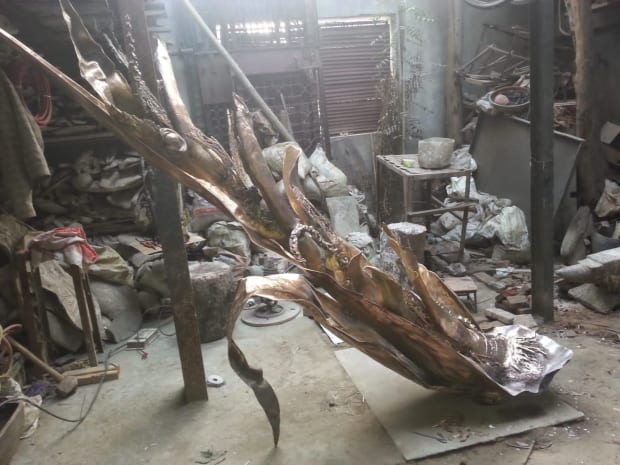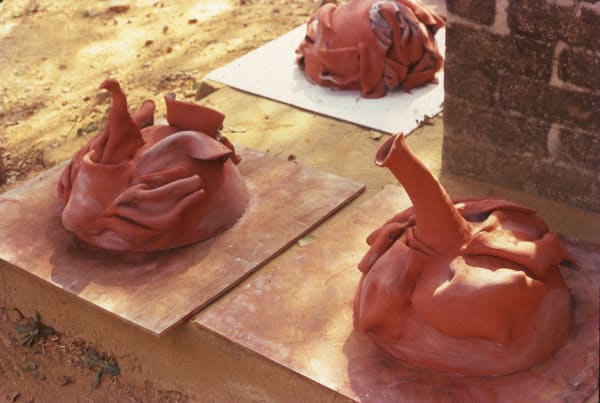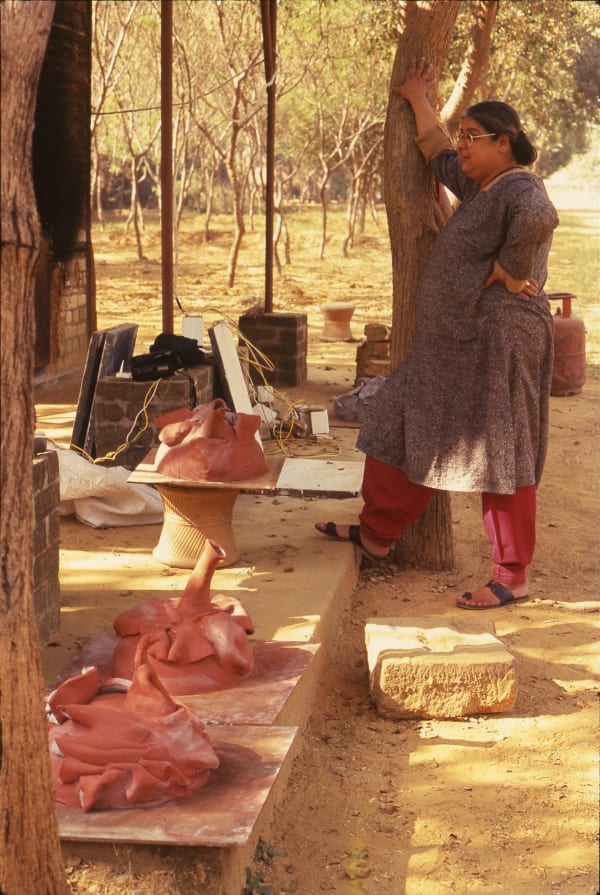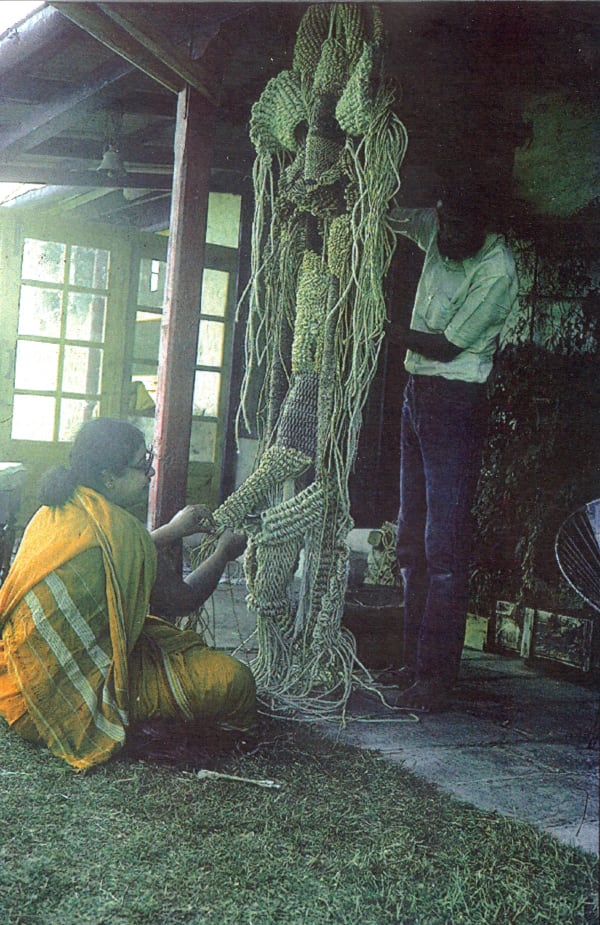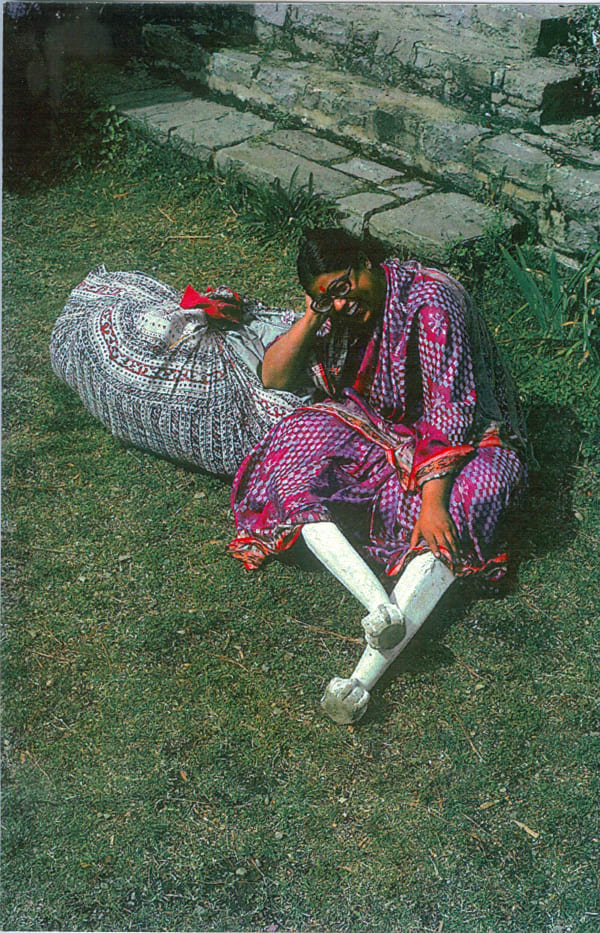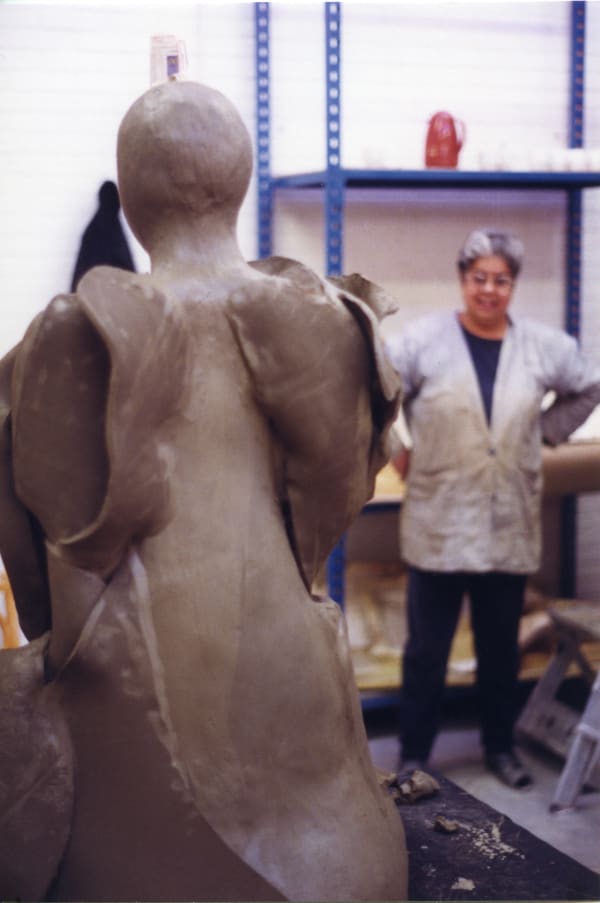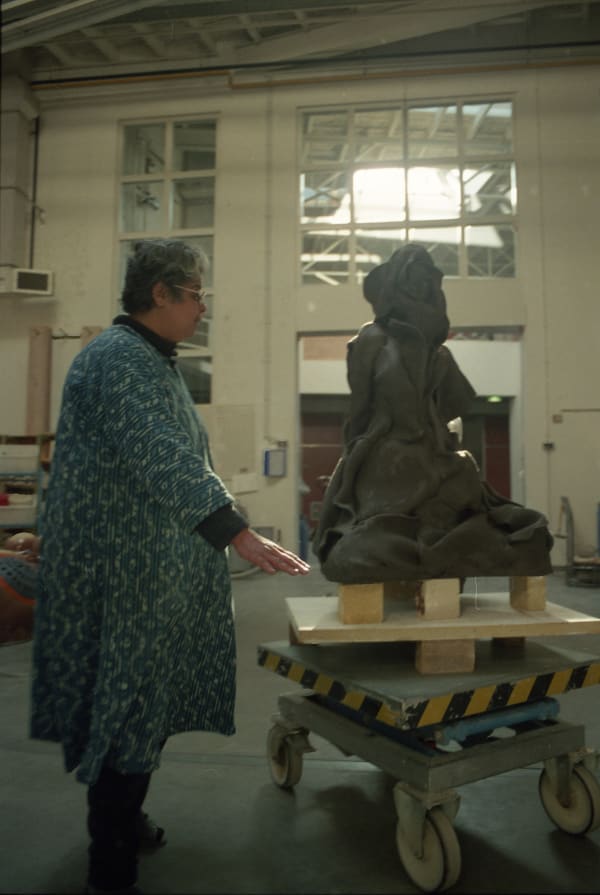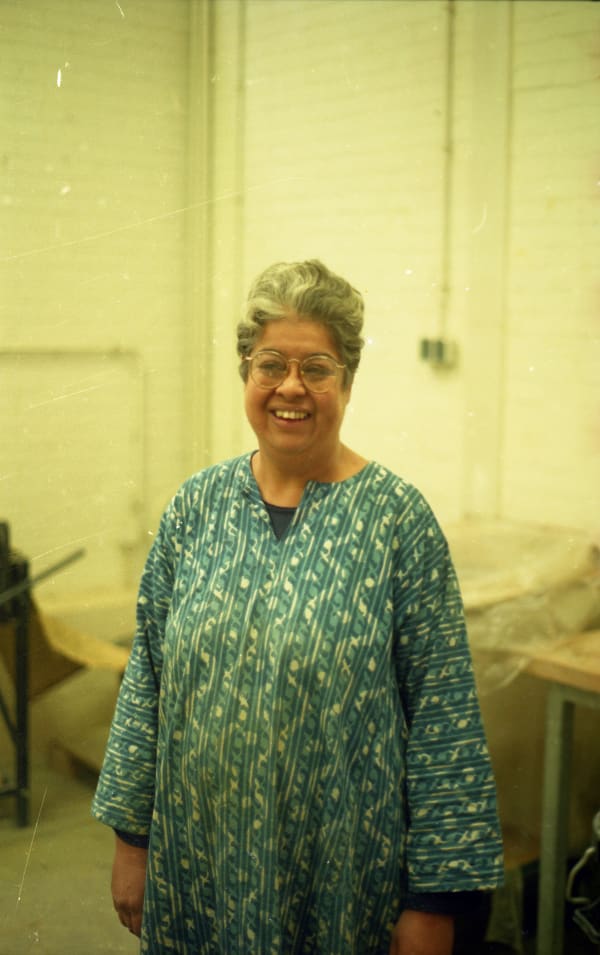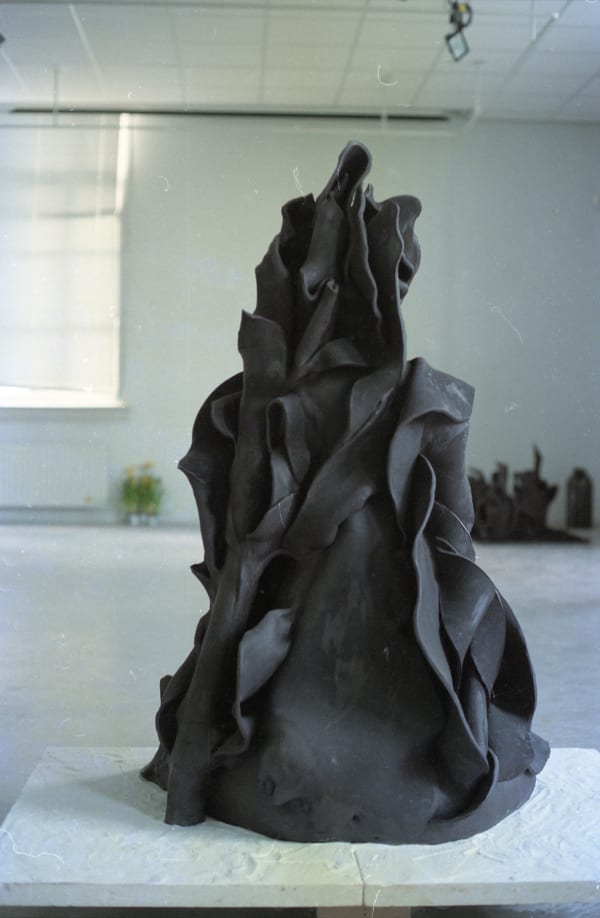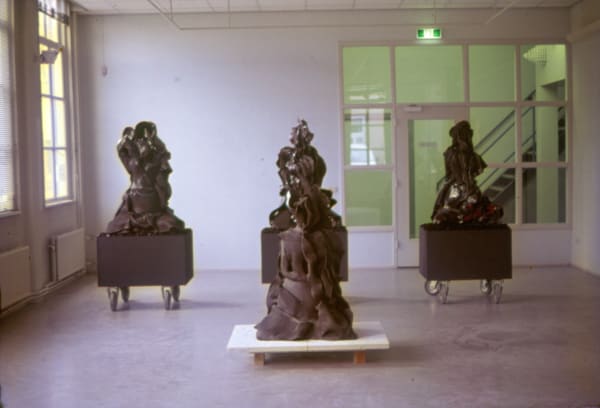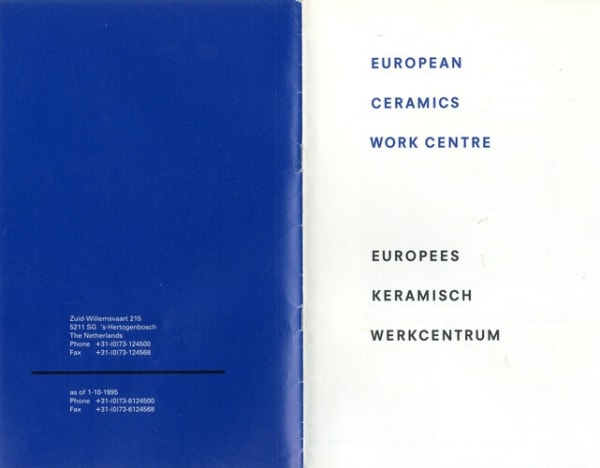-
 Mrinalini Mukehrjee engrossed in her workspace in New Friends Colony, New Delhi, 1985
Mrinalini Mukehrjee engrossed in her workspace in New Friends Colony, New Delhi, 1985 -
With Studio Practice, we enter the archives in search of the studio of Mrinalini Mukherjee. This exhibition, the first of many that explore the collections in the Mrinalini Mukherjee Foundation Archive, becomes a way of moving with the artist through the places she worked, the artists she encountered, the residencies and institutions she engaged with, and the works that emerged in between. In doing so, we begin to see the archive not only as a site of retrospection but as a space of return where process, memory, and material remain active and where Mukherjee’s legacy continues to unfold, shaped as much by her world as by those who now encounter it anew.
An artist's practice is often inseparable from the sphere it emerges from—the world of materials, processes, influences, and relationships centered in and around a studio. For Mrinalini Mukherjee, the studio appears, through the traces in her archive, not simply as a space of art making, but as a realm she continually pushed and stretched to meet the shifting demands of her expansive practice. It held not only the scale and complexity of her sculptures, but also the eclectic materials, foraged objects, and references she gathered around her; whether tools, textures, or fragments that fed into her evolving forms. In these images and records, we glimpse a space that was continuously adapted, improvised, and reimagined. Perhaps the studio lives on not only in what it held, but in how it enabled her to work, think, and experiment, offering the possibility to read it anew with each encounter. Through the archives, its resonance extends far beyond its once physical walls, inviting fresh interpretations of the spaces she moulded, and of Mrinalini Mukherjee herself, as an artist, collaborator, and individual deeply rooted in the practice she fervently pursued.
The Mrinalini Mukherjee Foundation’s Archive houses a remarkable collection of over 2,380 records, documenting Mrinalini’s pioneering career as one of India’s most significant sculptors. The physical archive offers a closer glimpse into her life and practice, encompassing photo documentation of her monumental fiber, ceramic, and bronze sculptures, detailed installation instructions, and other works that illuminate her creative process. The archive also opens windows into her personal and professional realms—letters exchanged with peers like Bhupen Khakhar and Nilima Sheikh, travel photographs with her architect husband Ranjit Singh, and a treasure trove of documents related to her parents, legendary artists Benode Behari Mukherjee and Leela Mukherjee.
-
-
The digital archive offers a way to experience Mukherjee’s practice as a multifaceted journey, shifting between materials and methods: from rope to bronze, botanical forms to architectural scale, folk to contemporary vocabularies, resisting any singular interpretation. It is from this oeuvre, a vast array of objects has surfaced —be it the letters, postcards, travel artifacts, photographs, negatives, contact sheets, books, and other material objects, each carrying its own context and narrative. Over the past few years, these fragments have been carefully cataloged and digitized, gaining new layers of meaning and purpose within the ever-expanding realm of ideas and interpretations in the art world.
Thus, the notion of the studio persists as a space that continually shifts, expands, and redefines itself. Through Studio Practice, we invite you to examine what a studio looks like when pieced together through images and documents. The stories that emerge when materials, tools, and traces of process are reassembled and drawn back to life. Discover from over 240 personal records, 350 correspondences, a vibrant collection of postcards, and hundreds of various ephemeras and publications in our repository— how personal and public histories intersect when the boundaries of the studio dissolve, as memories and materials blend with the traces of life and thought and Mukherjee's enduring legacy continues to evolve.
Welcome to the archives of Mrinalini Mukherjee. -
-
-
-
THE BASEMENT STUDIO
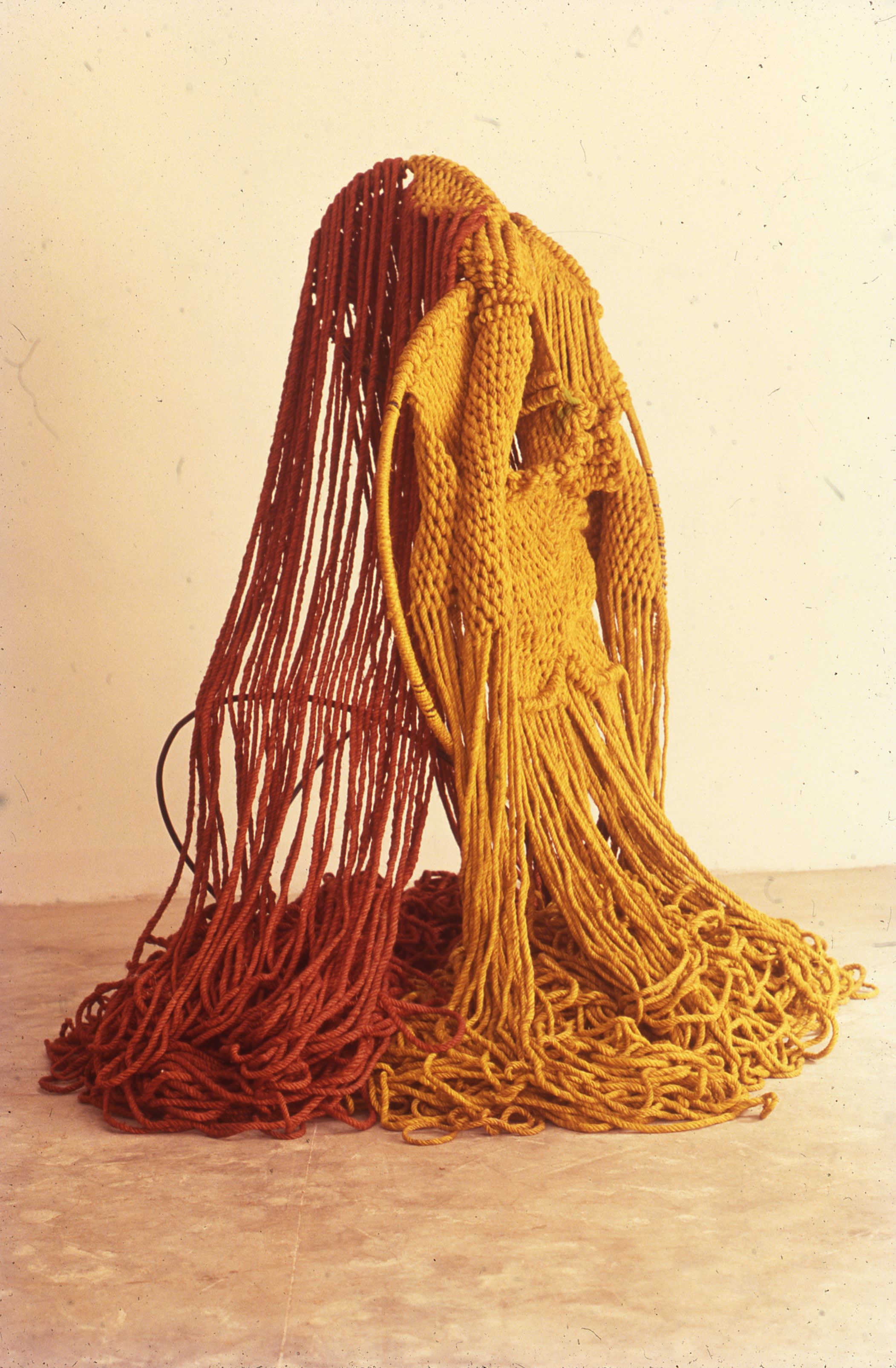
Pushp in process at Khirki Studio, 1993.
Photo credit: Randhir Singh.In 1976, Mukherjee received a commission for a large-scale mural at the Mahatma Gandhi Institute in Mauritius. This project required a different kind of studio—one that could accommodate a work of significant scale. She rented a basement studio in Khirki where she could lay out, construct, and refine her massive compositions.
To bring the project to life, she enlisted daily-wage laborers from Bhogal, who were skilled in stringing charpais (woven rope beds). Their technique of interlacing rope with precision mirrored elements of Mukherjee’s fiber work, reinforcing the link between traditional craftsmanship and her sculptural language.“The guiding principle was the image she had in mind... She would start work in a small room without worrying whether it could be taken out from there. Sometimes, we had to remove the door and its frame just to get the work out—she refused to be restricted.”
— Ranjit Singh in correspondence with Shanay Jhaveri, Phenomenal Forces of Nature 2019 -
Khirki Studio Experiments
-
Photographs from Mukherjee’s early studios, particularly the Barsati and later Khirki, capture her not only in the process of art-making but in moments of post-production, as she consciously experimented with how her sculptures might be seen, encountered, and experienced.She installed and suspended her works, playing with their spatial presence within the constrained studios. There is a sense of deliberate staging in these images: the floors are swept, the spaces cleared, the sculptures composed with care for the camera. These studios became immersive environments- precursors to the gallery- wherein Mukherjee intuitively choreographed how her work would be perceived. Through her own lens, and that of her husband Ranjit Singh, Mrinalini staged and documented the acts of tying knots, adjusting light, and framing—each an experiment in viewership, an exercise in evoking awe through arrangement and atmosphere. Hundreds of contact sheets and negatives reveal how she turned to photography to simulate the viewer’s gaze and study her forms from multiple angles. In these images, one sees a deep awareness not only of material, but of its eventual reception with each installation experimnt an intimate rehearsal in exhibition-making.
-
-
THE GARAGE STUDIO
For her British Council show in the 1980s, Mukherjee transformed a garage in New Friends Colony into her workspace. Unlike the openness of the barsati, this space was more enclosed, allowing her to control lighting and texture while focusing on developing intricate surface treatments on her fiber sculptures.
Photographs from 1985 show the garage studio filled with her towering fiber sculptures, floating mid-air as if frozen in motion. The density of hemp made these works physically demanding—some weighing close to a hundred kilos. Mukherjee often spoke of sculpting as an intense, almost combative process, where her own body was fully engaged in shaping, knotting, and maneuvering the material into form. The garage provided a contained space for this labor, allowing her to push the material to its limits while refining its texture and presence.
Assortment of images from the garage exhibition shows Mrinalini Mukherjee posed at work, as the sculptures Devi, Pakshi, and Yakshi suspended and photographed from multiple angles, all come together in the garage-turned-studio.
-
-
-
Residencies and Studios elsewhere
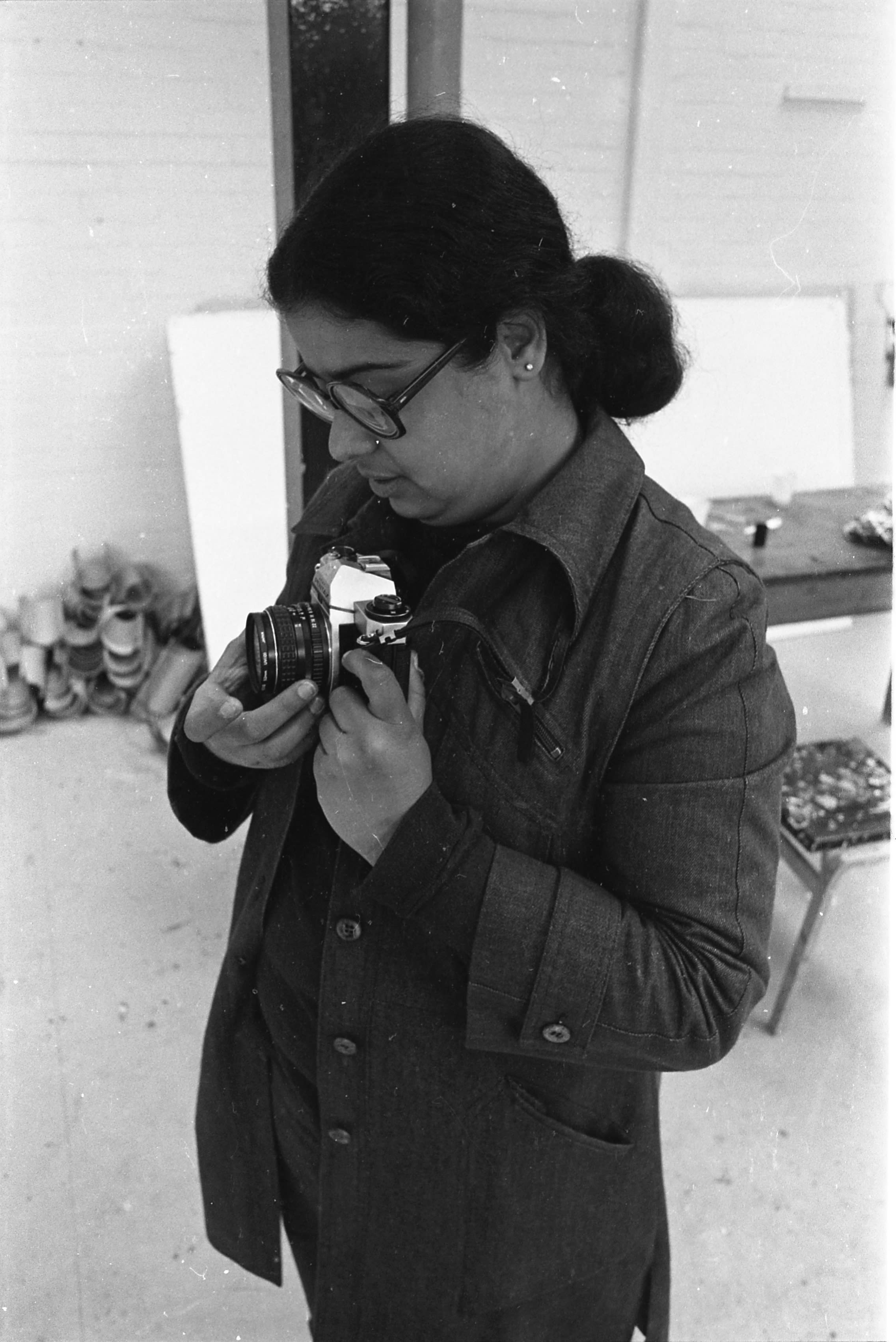
Mukherjee in england, 1978Through residencies like at the Kasauli Art Centre, or abroad at the West Surrey College of Art and Design or at Oxford's Museum of Modern Art, and later twice at the European Ceramic Workcentre (EKWC) in the Netherlands, Mrinalini Mukherjee’s practice extended well beyond Delhi’s studio ecology. In these transitory and often makeshift spaces, she engaged with unfamiliar materials, refined new techniques, and responded to shifting cultural landscapes. What emerges from the archives are fragments that reveal just how porous the boundaries were between travel, collaboration, and studio practice for Mukherjee during these residencies.Residencies often provide artists with dedicated time, space, and resources to experiment, reflect, and develop their practice outside the demands of their usual environments. For Mukherjee, they became sites of both possibility and constraint. While some offered access to new tools and scales, others required her to improvise in response to material scarcity.At the West Surrey College of Art and Design, for instance, Mukherjee struggled to find the quality ropes she was accustomed to in Delhi. In response, she began binding rope and long sticks; a solution shaped by necessity, but driven by her instinct for form. In contrast, her time at EKWC opened up the possibility of working at a scale she could not access at home. The state-of-the-art ceramic facilities allowed her to create ambitious, large-scale pieces that explored volume and texture with newfound freedom. However, such experiments proved difficult to sustain back in India, due to the absence of high-quality clay and kiln infrastructure.Despite these limitations, each residency added a new dimension to her evolving vocabulary showing how moments of adaptation, constraint, and discovery shaped her engagement with scale, form, and material possibilities. -
West Surrey Days
-

Mukherjee in her studio during her British Council Scholarship at the West Surrey College of Art and Design, 1978. She used this opportunity to travel within Europe and build lifelong connections.
-

In the absence of the quality ropes she was used to in Delhi, Mukherjee began experimenting by binding rope and long sticks—an improvisation shaped by context. Sample of the works she created during her time in England.
-
-
Sanskriti Studio Sessions
-

Mukherjee's first experiments with clay, shifting away from fiber toward a new medium that demanded a different kind of process and material sensitivity. Photo credit: Ranjit Singh
-

Lotus Pond in shifting earth tones, achieved by the degree of of firing.
-

Wood-fired kilns at Sanskriti Kendra.
-

In 1995, Mukherjee participated in a ceramic workshop at Sanskriti Kendra, part of an Indo-Dutch collaboration that brought together Indian and Dutch artists at Anandgram, then on the outskirts of Delhi.
-
-
Snapshots from the Kasauli Art Centre
-

At artists’ workshop, Kasauli Art Centre in 1977, Mrinalini seen working on Wood Spirit with artist Chandrakhant Bhatt. Image courtesy: The Estate of Vivan Sundaram.
-

Kasauli Art Centre, founded by Vivan Sundaram in 1976, brought together artists, critics, and performers in a close-knit creative environment. At Ivy Lodge, Kasauli Art Centre, 1977: top row, from left D.L.N. Reddy, Tara Sabharwal, Chandrakant Bhatt; middle row, from left Mrinalini Mukherjee, Vivan Sundaram, Chameli Ramachandran, Ghazanfar Zaidi; bottom row A. Ramachandran with his children Rahul and Sujata. Courtesy: The Estate of Vivan Sundaram
-

Artists’ workshop, Kasauli Art Centre, 1979: from left Nagji Patel, Dhruva Mistry, Mrinalini Mukherjee and K.G. Subramanyan. Courtesy: The Estate of Vivan Sundaram
-

Mukherjee captured in a light, almost playful pose at Ivy Lodge, Kasauli Art Centre, 1977, far removed from her Delhi routine and setting. Courtesy: The Estate of Vivan Sundaram.
-
-
Notes from Netherlands
-

European Ceramic Work Centre (EKWC), where Mukherjee was in residence in 1996 and again in 2000, is an international hub for artists, designers, and architects exploring ceramics, often for the first time. With access to advanced facilities and technical support, it offered Mukherjee the freedom to experiment and expand her sculptural prowess in clay. Photo credits: Anne Maria Borsboom.
-

Work in process of getting fired in a kiln. Photo credits: Anne Maria Borsboom.
-

Photo credits: Anne Maria Borsboom.
-

Photo credits: Anne Maria Borsboom.
-

Caught in media res. Photo credits: Anne Maria Borsboom.
-

Photo credits: Anne Maria Borsboom.
-

Ranjit Singh in the backgrounds of the studio. Photo credits: Anne Maria Borsboom.
-

Installation view of Ceramic works at EKWC. Photo credits: Anne Maria Borsboom.
-

A moment from the studio at EKWC. Photo credits: Anne Maria Borsboom.
-

Mukherjee is seen working alongside her husband, architect Ranjit Singh, who assisted her. Photo credits: Anne Maria Borsboom.
-

Photo credits: Anne Maria Borsboom.
-

Brochure from 1996, an ephemera from Mukherjee’s residency at EKWC.
-
-
With Studio Practice, we enter the archives not only to trace the sites of Mukherjee’s practice, but to ask what a studio means when it exceeds walls and physical spaces.
This exhibition, the first of many, becomes a way of moving with her through the places she worked, the artists she encountered, the residencies and institutions she engaged with, and the works that emerged in between. In doing so, we begin to see the archive not as a site of retrospection, but as a space of return where process, memory, and material remain active, and where Mukherjee’s legacy continues to unfold, shaped as much by her world as by those who now encounter it anew.
-
ReferencesShanay Jhaveri, Phenomenal Forces of Nature, in Mrinalini Mukherjee (The Shoestring Publisher, 2019).
Nilima Sheikh, Ruse for Wonderment, in Transfigurations: The Sculpture of Mrinalini Mukherjee (Archana Press, 2017).The Andy Warhol Museum, “Time Capsule 21: Artwork,” 2003, https://www.warhol.org/timecapsule/andy-warhols-time-capsule-21/time-capsule-21-artworkCuratorial text by Haifa Maryam, with inputs from Bhooma Padmanabhan and Sheila Makhijani.Images and documents from the archive have been digitized in collaboration with Asia Arts Archive.
All images, videos, text, data and material (hereafter "content") on this site are protected by copyright. Mrinalini Mukherjee Foundation has taken all efforts to identify and state the name of the author of said content, or institution to whom the content belongs. Mrinalini Mukherjee Foundation and relevant third parties, own and expressly reserve all rights, including copyright, in whole and in part, throughout the world, for the contents on this website. Copying, distributing, modifying, transmitting, reusing, downloading, or using the contents of the site without the express prior written permission of the Mrinalini Mukherjee Foundations could be a violation of copyright laws.To obtain permission for use of content from the site (i.e. images, text, video and/or data) please write to us at info@mrinalinimukherjeefoundation.org
© All rights reserved. Images and archival material remain the property of their respective photographers and copyright holders. This content is intended for educational and non-commercial use only. No part of this material may be reproduced, stored, or transmitted in any form without prior permission from the Mrinalini Mukherjee Foundation. -
In the coming days, Mrinalini Mukherjee Foundation will continue to revisit and expand upon these threads through public programs, conversations, and workshops. Stay tuned for updates.

